2015
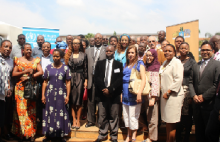
Regional Meeting in Africa on Urban HEART
The WHO Kobe Centre co-hosted a meeting of seven countries from WHO’s Africa region in Ezulwini, Swaziland, on October 14-16, 2015. The seven countries included the hosts Swaziland, Algeria, Burundi, Mali, Malawi, Uganda, and Zimbabwe. The main objective of the meeting was to take stock of progress made in introducing or applying Urban HEART in the field, and share information on experiences in different countries. WHO’s role was to provide further guidance and support to countries for utilising the tool in order to catalyse efforts to improving health equity in urban areas. During the meeting, participants were also taken on a field visit to experience and critique progress made with interventions based on Urban HEART in Matsapha Municipality, Swaziland.
Urban HEART is a tool developed by the WHO Kobe Centre to support cities and countries assess and respond to health inequities at the local level. The tool has been used in more than 100 cities in 53 high, middle- and low-income countries till date. This meeting was the fourth major Urban HEART workshop or consultation in 2015. Previous meetings in 2015 have been held in Kobe (Japan), Tehran (Iran), and Seoul (Republic of Korea).
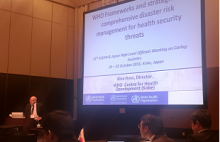
13th ASEAN and Japan High Level Officials Meeting on Caring Societies: “People-centred disaster risk reduction and restoration”
The WHO Centre for Health Development (WHO Kobe Centre/WKC), in coordination with WHO Headquarters, the WHO Regional Office for the Western Pacific and the WHO Regional Office for South-East Asia, represented WHO and presented WHO strategic frameworks for disaster health risk management at the three-day 13th ASEAN and Japan High Level Officials Meeting on Caring Societies held in Kobe, Japan, 20-22 October 2015. Eleven country delegations attended with participants from health, social welfare and labour ministries, as well as WHO, ILO, ASEAN, ADB, JICA, and the Asian Disaster Risk Reduction Center.
Organized by Japan’s Ministry of Health, Labour and Welfare annually since 2003, the meeting is recognized as a vital and effective platform to support the ASEAN plus Three (Japan, People’s Republic of China and the Republic of Korea) countries. The theme of this year’s meeting was “People-centred disaster risk reduction and restoration”. Mr Alex Ross, Director, WKC, delivered a composite presentation about “WHO frameworks and strategies for comprehensive disaster risk management for health security threats” and facilitated a panel discussion on provision of medical care at the time of disaster. WKC Technical Officers, Dr Ryoma Kayano and Dr Jostacio M. Lapitan, also attended.
Conclusions of the meeting, captured in a Statement, included strategic recommendations for a) operationalizing coordinated health-social welfare-employment support systems responsive to the needs of populations in general b) specific actions to serve vulnerable populations, namely, women and children, older people, people with disabilities, indigenous people and migrants; and called upon all participants to c) support the implementation of global compacts such as the Sendai Framework for Disaster Risk Reduction 2015-2030, the International Health Regulations (2005), and the Sustainable Development Goals; d) ensure basic functioning of health systems to enhance disaster risk management for all hazards; and e) expand cross-sector collaboration among health, social welfare, labor, and disaster management. ASEAN will use incorporate the conclusions of the meeting into their “One ASEAN, One Response: ASEAN Responding to Disasters as One" plan.
Related links:

New WHO World Report on Ageing and Health: creating a new vision for healthy ageing
On the International Day of Older Persons, WHO released the first World Report on Ageing and Health. For the first time in history, most people can expect to live into their sixties and beyond. Yet there is little evidence to suggest that older people today are experiencing better health than previous generations at the same age. A transformation in health and long-term care systems will be required.
By age 60, adults face major burdens of disability and death arising from losses in hearing, seeing and getting about, in addition to noncommunicable diseases such as heart disease, stroke, chronic respiratory disorders, cancer and dementia. Older people are also at much greater risk than younger people of experiencing more than one chronic condition at the same time.
The report outlines a new concept of “healthy ageing” that shifts our thinking about health in older persons from solely the presence or absence of disease to a focus on an older person’s well-being, as well as their ability to function well and meaningfully within the context that they live in. The Report also presents evidence and a set of recommendations calling for radical changes not just to health and social care systems, but also to the way society perceives older people and supports them, if we are to collectively benefit from these extra years of life. Today’s focus on treating individual diseases must give way to services that ensure coordinated and integrated care and support that enable people to maintain the highest level of physical and mental capacity for as long as possible. Development of comprehensive systems of long-term care will be required.
Actions across sectors will also be required involving decision-makers from housing, transport, employment and finance ministries to work collaboratively with health experts to build age-friendly environments that enable older people to continue to contribute to their communities and to society as a whole for as long as possible.
Innovation is at the heart of further transforming our systems and societies to respond. Universal health coverage (UHC) provides an excellent opportunity to develop health and social delivery systems to support older persons. Capitalizing on the many lessons from Japan, the global WHO Kobe Centre’s new ten year research strategy on UHC and innovation for ageing populations is documenting social, system and technological innovations that are fit for purpose and respond to the needs of older persons and to design coordinated and integrated health and social care systems.
Various successful models can be adapted, expanded and introduced in other countries. Many of these will be highlighted at the WHO Global Forum on Innovation for Ageing Populations, in Kobe on 7-9 October.
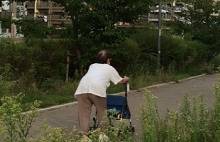
New WKC Publication: “Assistive technologies for ageing populations in six low-income and middle-income countries: a systematic review”
A new publication prepared by the WHO Kobe Centre, “Assistive technologies (AT) for ageing populations in six low-income and middle-income countries: a systematic review”, was published by the British Medical Journal Innovations (BMJ) on 11 September 2015. WKC conducted a systematic literature review of the current availability of AT, and existing legislation for provision of AT, for older adults in six low- and middle-income countries (LMIC), which are among countries with the highest estimated 65 and over population in the coming decades: Brazil, Cambodia, Egypt, India, Turkey and Zimbabwe.
The review was based on research using multiple databases retrieving an initial total of 538 relevant records, which were screened using specified criteria to yield 17 relevant studies. In summary, AT for ageing populations have received some attention in LMIC, and the limited set of studies reflects the emerging nature of this field. Key findings were that the six LMIC have some degree of available AT designed for older adults with an impairment or disability, but limited AT to prevent such impairment or disability; 2) production of AT in LMIC is currently low, 3) those LMIC with AT initiatives generally for disabled populations (e.g, Brazil, Cambodia, Egypt and India) have started production of low-cost AT, and all of the study countries had ratified the UN Convention on the Rights of Persons with Disabilities. Analysis of review findings indicated the need for a comprehensive, integrated health and social system health system approach in order to increase the current availability of AT for ageing populations in LMIC. These would entail, yet not be limited to, work on: 1) promoting initiatives for low-cost AT; 2) awareness raising and capacity building on AT; 3) bridging the gap between AT policy and practice (including relevant legislation and incentives); and 4) fostering targeted research on AT.
Keshini Madara Marasinghe, Jostacio Moreno Lapitan, Alex Ross. Assistive technologies for ageing populations in six low-income and middle-income countries: a systematic review. BMJ Innovations, 2015;0:1-14, 11 September 2015.
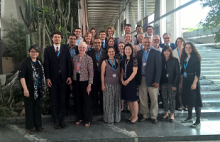
Meeting of Pilot Sites of the Age-friendly City Core Indicator Guide
The WHO Kobe Centre (WKC) conducted a pilot study in 15 sites to test the feasibility of measuring indicators of age-friendly cities and communities in diverse contexts around the world.
The 15 pilot sites in 12 different countries each made their best attempt at gathering data to measure indicators aimed at addressing the accessibility of the physical environment, the inclusiveness of the social environment, the impact on quality of life, and the equity dimensions of each, all within the context of their local community.
Upon completion of the study, representatives of the pilot sites were convened in WHO Geneva Headquarters on 10-11 June, 2015, to discuss the importance of the adaptability of the indicators and other issues that will contribute to the finalization of the indicator guide.
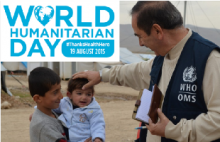
World Humanitarian Day ~THANKS HEALTH HERO!~
World Humanitarian Day is a time to recognize those who face danger and adversity in order to help others. It is also an opportunity to celebrate the spirit that inspires humanitarian work around the globe. The day was designated by the General Assembly to coincide with the anniversary of the 2003 bombing of the United Nations headquarters in Baghdad, Iraq.
WHO’s theme for this year’s World Humanitarian Day is “Thanks Health Hero!” To mark the event, WHO is launching a campaign focusing on health workers who provide healthcare under challenging circumstances whether it be in a conflict, natural disaster, communicable disease outbreak, or in resource poor settings.
WKC joins this campaign in honouring health workers worldwide and our partners in Japan, who dedicate their lives to working in public health. Health workers act as humanitarians by ensuring that health is a fundamental right of every human being, as stated in the WHO constitution.
Health workers are at the front lines serving others without regard to race, colour, nationality and their own lives. They are the guardians of health. In Guinea, Liberia and Sierra Leone, 875 health worker Ebola infections were reported as of 5 July 2015. More than half of them - 509 health workers died. In 2014 alone, 603 health care workers died, and 958 were injured, from violent attacks during humanitarian emergencies in 32 countries in 2014.
Health workers work under exceptionally challenging circumstances. The Sendai Framework for Disaster Risk Reduction included over 30 actions to support health emergency management. World Humanitarian Day begins the countdown to the first World Humanitarian Summit will take place in May 2016 in Istanbul Turkey that will mobilize worldwide action to respond to humanitarian crises. WHO, and the WHO Kobe Centre, supports countries in many ways during humanitarian agencies.
-- WHO Humanitarian Health Action
-- WHO Western Pacific Region/Emergency and Humanitarian Action
WKC honours the many health workers and institutions in Japan who selflessly come to the aid of others. The only WHO Collaborating Centre dedicated to Nursing in Disaster Situations is located at the University of Hyogo, and the Kochi University, the University of Hyogo School of Nursing, and three other Japanese schools of nursing have launched an innovative doctoral programme in nursing in disaster situations.
Join us as we send messages of thanks to health heroes around the world using the hashtag #ThanksHealthHero.
****
WHD is designated by the General Assembly, and a world-wide campaign organised by UN agencies including OCHA and their partners.
Related links:
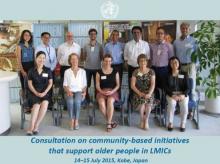
Exploring New Models of Community Initiatives for Older Adults – an Expert Consultation
In many societies, health and social care primary support is provided by the immediate family circles. Demographic growth, urbanization, and the changing composition of family units have challenged this assumption in the last decades. In response to drastic demographic and social changes, as well as the growing need for care support among ageing populations, the WHO Kobe Centre (WKC) launched a call for case study on models of community-based care in low- and middle- income countries in 2014.
Eight case studies had been selected representing a diversity of options to provide support to older adults in their communities, as well as to engage older adults to care for their peers. These case studies provide a key starting point to discuss issues related to the changing role of caregiving, the position of community-based initiatives within health systems, the types of services delivered or referred to, and the challenges of determining clear outcomes and metrics to measure progress.
The expert consultation convened in Kobe from 14 to 15 July 2015 gathered 8 experts from Australia, Canada, India, Italy, Poland, South Africa, Uganda, Viet Nam, as well as WKC researchers, to review the experience of selected initiatives conducted in China, India, South Africa, Thailand, Poland , Uganda, and Viet Nam.
The discussions focused on identifying how and with which depth these initiatives respond to the gaps in health and social care for older people. The conclusions of the consultation allow for the development of the second phase of the research, with a stronger focus on the diverse range of initiatives in middle- and high- income countries. The ultimate purpose is to derive key principles for the implementation of community-based models of care for older adults, articulated around people-centred and integrated health and social care approaches.
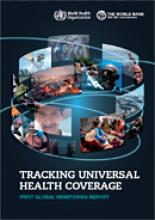
New WHO and World Bank Group report monitoring universal health coverage
A World Health Organization and World Bank Group report launched on 12 June shows that 400 million people do not have access to essential health services and 6% of people in low- and middle-income countries are tipped into or pushed further into extreme poverty because of health spending.
The report, Tracking Universal Health Coverage, is the first of its kind to measure health service coverage and financial protection to assess countries’ progress towards universal health coverage (UHC). Implementing UHC is a Target within the proposed post-2015 Development Goals.
A commitment to equity is at the heart of UHC. As more countries make commitments to universal health coverage, one of the major challenges they face is how to track progress.
This is the first in a series of annual reports that WHO and the World Bank Group will produce on tracking progress towards UHC across countries. The report was supported by the Rockefeller Foundation and the Japanese Ministry of Health.
The report looked at global access to essential health services – including family planning, antenatal care, skilled birth attendance, child immunization, antiretroviral therapy, tuberculosis treatment, and access to clean water and sanitation – in 2013, and found that at least 400 million people lacked access to at least one of these services.
The report also found that, across 37 countries, 6% of the population was tipped or pushed further into extreme poverty ($1.25/day) because they had to pay for health services out of their own pockets. When the study factored in a poverty measure of $2/day, 17% of people in these countries were impoverished, or further impoverished, by health expenses.
WHO and the World Bank Group recommend that countries pursuing universal health coverage should aim to achieve a minimum of 80% population coverage of essential health services, and that everyone everywhere should be protected from catastrophic and impoverishing health payments.
The WHO Kobe Centre has translated the executive summary of the report into Japanese.
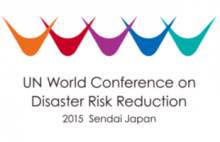
The third World Conference on Disaster Risk Reduction (WCDRR)
The third World Conference on Disaster Risk Reduction was held from 14 to 18 March 2015 in Sendai City, Miyagi Prefecture, Japan. Countries from around the world reviewed and updated the Hyogo Framework for Action, endorsed in 2005 at the Second World Conference held in Kobe. Health issues and strategies to protect the health of people in disasters will be much more important in the revised framework. During the Conference, there were events for the general public, including symposiums and exhibitions on themes related to health and disaster risk reduction and management.
On March 17, WHO, UNAIDS, UNFPA, and UNISDR co-organized a public forum “PROTECTING PEOPLE’S HEALTH FROM DISASTER RISKS”. Over 30 speakers from all over the world and from the fields of disaster prevention, public health, medicine, and more spoke on comprehensive disaster risk reduction and management for health. The full day Forum was organized in 7 sessions covering many topics in health emergency management.
Flyer
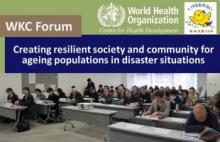
WKC Forum report: Creating resilient society and community for ageing populations in disaster situations
In commemoration of the 20th anniversary of the Great Hanshin-Awaji Earthquake, the WHO Kobe Centre, in collaboration with the University of Hyogo, organized an open public forum on “Creating resilient society and community for ageing populations in disaster situations” in Kobe on 20 February 2015 and 43 audiences participated in the event.
In the Forum, five experts presented their knowledge, research outcomes, and suggestions from various perspectives including nursing and disaster management, social welfare for older populations, psychology, and community healthcare to explore major components of resilient society/community with ageing population. The presentations were based on the experts’ experiences and interaction with older populations.

Japan has the largest proportion of older adults in the world. As a result, aged populations were much more affected, and accounted for more than half the victims in the 1995 Great Hanshin-Awaji Earthquake and in the 2011 Great East Japan Earthquake. Survivors must cope with physical, psychological and social issues, e.g. linkage with neighbours is interrupted leading to more social isolation, continuity of medical care and access to healthcare systems can often be unavailable. Once the essence of a “community” is lost, it takes a amount of tremendous time to achieve their reconstruction. It was also suggested that we can effectively restore communities if people prepare countermeasures against natural disasters in times preceding a disaster. Resilience in a community can be developed through enhancement of residents’ mobility and support system for cooperation – something that can be limited in ageing societies that increases their vulnerability.
In the Forum, five experts presented their experiences: Dr Mitani, Associate Professor of Kyoto University, reviewed the epidemiology of health conditions affecting older persons after the Great East Japan Earthquake, that included identification of health risks experienced by older populations in temporary housing. This is important to prevent secondary deaths that are relevant to and happen after the initial disaster. Dr Kako, Consultant of the WHO Kobe Centre, presented a framework for disaster prevention relevant to global population ageing, focusing on restoration and rehabilitation after disasters. Dr Okamoto, Head of Protection Section, Tarumi Ward Office in Kobe City, reported lessons learned after the Great Hanshin-Awaji Earthquake and emphasized the need to support vulnerable communities and older people's health at all times –this was best way forward to supporting older persons during a disaster. Professor Yamamoto, Director of WHO Collaborating Center for Nursing in Disasters and Health Emergency Management, University of Hyogo, described efforts and research to support older people's health after an earthquake through the activity of the “Public health room in communities” and brought up the importance of social support as well. Dr Ochi, Director of Soma Central Hospital, pointed out the health impact of radiation and long-term evacuation at temporary houses based on her observations in Fukushima Prefecture after the Great East Japan Earthquake.
The speakers identified a few key recommendations emerging from their research and observations from the Great Hanshin-Awaji Earthquake in 1995:
- The significant need to address psycho-social issues such as social isolation and increasing older persons’ ability to monitor their health after a disaster.
- During the last 20 years, there has been an increased attention to the roles of respective organizations/authorities in emergencies to the needs of older persons that have helped planning for future disaster situations.
- Interaction and information exchange among organizations are indispensable on a daily basis for effective rescue and comprehensive support after natural disasters.
- The concept of disaster prevention needs to be included in everyday life. There is a great opportunity for older persons to be more involved in planning and activities for disaster prevention in ageing societies.

Programme & Speakers
Presentations (Japanese)
- "Older people’s health after the Great East Japan Earthquake: from the epidemiological perspective"
Dr Satoko Mitani, Associate Professor, Unit for Liveable Cities
Graduate School of Medicine, Kyoto University
- "Ageing society and disaster: report from global perspective"
Dr Mayumi Kako, Consultant
WHO Kobe Centre
- "Older people's health after the Hanshin Awaji Earthquake: learning from community support activities"
Dr Kazuhisa Okamoto, Head of Protection Section, Health/Welfare Dept.
Tarumi Ward Office, City of Kobe
- "Supporting people’s health through the activity of ‘Machi no Hokenshitsu (Public health room in communities)’"
Professor Aiko Yamamoto, Director, WHO Collaborating Center for Nursing in Disasters and Health Emergency Management
University of Hyogo
- "Health issues among the elderly after the Great East Japan Earthquake: a case in Fukushima"
Dr Sae Ochi, Director of Internal Medicine, Soma Central Hospital
Research Fellow, Imperial College London

